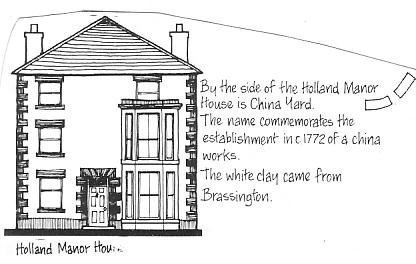---------------------------------------------------------p.25--------------------------------------------------------------
The China Factory at Wirksworth, in Derbyshire.
by Thomas L. Tudor.
|
THE early history of English china is still full of
problems, in spite of long-continued research. While it
is now hardly probable that entirely new factories will
ever be brought to light, there is still a fair margin for
discovery as to the output of the lesser works, and, for
the matter of that, of the more important ones -also,
especially as regards their earlier years. Among the
former we may place the factory at Wirksworth, in
Derbyshire, which, although noticed by certain past
writers, has, nevertheless, not yet been fully and critically
investigated.
The present article does not profess to be in any sense
exhaustive, but the facts here presented to the readers
of THE CONNOISSEUR will probably be sufficiently new
to constitute what is practically a rediscovery of the whole
subject. The writer feels justified in making this claim,
for the simple reason that modern works on china almost
entirely ignore the subject, notwithstanding the earlier
references quoted below. And even if Wirksworth
china does not stand in the front rank among collectors'
treasures, an enquiry into the subject may, nevertheless,
clear up certain matters that have hitherto lain about
the borderland of knowledge. At all events, it is obvious
that the question presents a problem which should be
faced in the interest of the whole subject of old china.
A first statement of this new approach to the subject
was made by the present writer in the Journal of the
Derbyshire Archiological Society for the year 1916, and
attracted some general attention. Since then much fresh
light has been gathered, and further specimens have
become accessible for purposes of illustration. This
article is therefore entirely rewritten. But it is highly
probable that the question will continue to expand, and
that certain matters, still obscure, will eventually be
cleared up.
Mr. Llewellynn Jewitt, writing about the year 1877
(Ceramic Art in Great Britain), gives a quotation stated
to be from Dugdale, which seems to indicate that china
was made at Wirksworth, in the Holland Manor House,
about the year 1759. He says the attempt was unsuccessful,
but as the factory went on for some years, this
remark would appear to refer to the financial side of
the undertaking. The same author quotes from a lease
(dated 1777) concerning the property, in the following
terms : " All those several messuages, etc., heretofore
used for the making of china ware," and comments thus:
"So that at that time the first china works had probably
ceased to be in operation." The italics are mine. What
does Jewitt mean by " first china works "? We naturally
suppose that there was a later period of china-making
here, and that the years before 1777 were not the limit
of the period of output. The indications are that there
was a second and later period.
Jewitt, indeed, gives indication of this. He says, in
the Sketch of the Life of William Billingsley, the famous
craftsman in china: "In 1804 he is stated to have commenced,
or joined, some small china works at Torksey,
in Lincolnshire, and a few years later he appears to have
No I. MANOR HOUSE TEA SET

|
---------------------------------------------------------p.26--------------------------------------------------------------
No II. MANOR HOUSE TEA SET
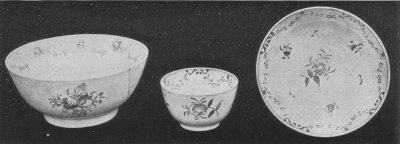
|
started a china manufactory at Wirksworth, in Derbyshire."
The context explains that he (Billingsley) was
attracted there by the existence of a beautiful white clay
found in connection with the lead-mines of the neighbourhood.
The same author states elsewhere that Billingsley
attempted to establish china works here, probably owing
to felspar being found in the locality. This time, how
ever, he says "there is no proof." Jewitt is rather loose
sometimes.
The next author to refer to the subject is William
Chaffers; who, in 1863, published his Marks and Mono
grams on Pottery and Porcelain: "About the year 1770
there was a manufactory of china here (Wirksworth),
said to have been established by a person of the name
of Gill. Pottery was first made, and a punch-bowl of
copper-coloured lustre, in the possession of Mr. Lucas,
of Bentley Hall, Ashbourne, is believed to be a specimen
of the manufacture. They afterwards made porcelain (soft paste),
the usual decorations being flowers
roughly painted, and shells ; tea services (with) white
and gold borders. No mark is known." Chaffers
again, in 1872, in a noble work entitled Keramic Gal
lery, makes a slight but similar notice ot the factory,
and gives what is practically the only illustration that
has ever appeared among these older writers. But it is
insignificant and of little use.
We now come to a much fuller reference to the subject,
from the joint pens of William Bemrose and Alfred
Wallis, published in 1870. In that year a Fine Art and
Industrial Exhibition was held in Derby, and the authors
above named wrote, for the guidance of visitors, a sketch
of the history of fictile art in the county, under the title
of The Pottery and Porcelain of Derbyshire. The passage
dealing with Wirksworth is interesting in the extreme,
though it seems a little high-flown in its statements:
" This factory must have been upon a very large scale,
and probably was even more extensive than the Derby
works, which it preceded as a china factory,* but to
whose rising power it was obliged to succumb in 1777,
when it was finally broken up. The goods made here
were of the very finest description, and specimens may
occasionally be met with, both of china and earthenware,
the decorations of which are very similar to those of
Lowestoft. "
* This seems incorrect.
No III. YOKECLIFFE SET
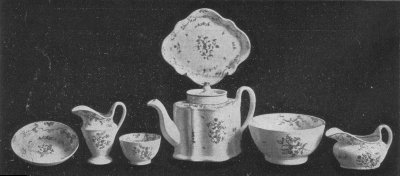
|
---------------------------------------------------------p.27--------------------------------------------------------------
No IV. GELL SET

|
We have not space to give the whole quotation. The
writers say the green colour is bright and peculiar, the
paste white and very translucent, the pottery soft and
fragile. It might seem that there were important specimens
in this exhibition which have since been lost, but
on turning to the exhibition catalogue we are surprised
to find only three small exhibits, viz., "cup and saucer,"
"custard cup and saucer," and "sucrier." The following
passage also seems to lack critical quality, but we
shall have something. more to add on this side of the
subject later on : " We are in a position to state that
figures of a graceful character, beautifully moulded urns,
and lamps, were made here." It is when we come to the
conclusion of the notice that we find ourselves able to
agree with these authors, on account of the evidence
presented by the illustrations to this article : "Tea ware
of a find and translucent paste (was) manufactured."
In Jewitt's time excavations were made on the site of
the Wirksworth factory, when, to use his own words,
portions of saggars and of china were found. Some of
these are in my possession." Unfortunately, there is
now no trace of these finds, but in 1914, when a drain
was being laid at the Holland Manor House, similar
discoveries were again made. Also a portion of the old
flue was exposed. At this time saggars, lumps of china
clay kneaded into balls, stilts for packing the ware in the
No V. WALL SET
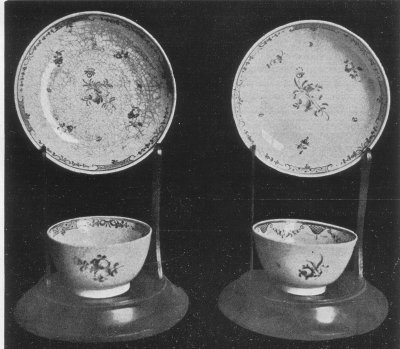
|
ovens, and numerous fragments of unglazed wasters, were
found.
The latter tended, without doubt, to establish the evidence
as to the Wirksworth output. The paste at its
---------------------------------------------------------p.28--------------------------------------------------------------
No VI. TWO TEAPOTS Bemrose Collection CUP AND SAUCER, WHITE AND GOLD
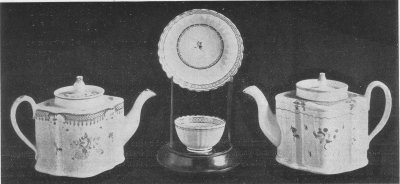
|
best is fine and tolerably translucent; smooth, fragile, and
slightly warm-grey in colour. Many thin pieces are
evidently parts of tea services, and others, thicker and
finely moulded, seem to bear out in some degree the
eulogy in the exhibition catalogue as to beautifully
moulded objects (see No. X.). Jewitt's finds seem to have
been lost long since, but if he turned up more than were
found in 1914-and he may well have done so, being first
on the scene-there is some justification for the Bemrose
assertions. But at present these seem overdrawn. Nothing
whatever is known of any figure work.
The Wirksworth paste is not the softest variety. It is
cut by the file only with considerable pressure. But the
magnifying glass shows a dull, flour-like powder, and not
vitreous particles. Here and there along the fracture
there are shining particles, perhaps of unreduced felspar.
But the general appearance is that of dull lump-sugar.
Chemical analysis is being awaited*.
[* See note at the end of this article.]
The writer is of opinion that the finds indicate two
periods-the period to 1777 and a period after 1804. The
photograph (No. X.) shows what are evidently fragments
of the earlier products, but, unfortunately, there are not
many complete specimens extant. The cup and cover
(No. VIII), belonging to Mrs. Meade Waldo, seem of this
period. They are well potted, though the glaze is some
what heavy in hue and slightly peppered in places. The
ornament is bold and striking, and consists of strong but
not crude colouring. Roses, honeysuckle, and foliage are
the motive, and the handles are ribbed and twisted. At
the points of attachment of the latter there are small,
raised, delicately moulded daisies left in the white. This
specimen is authentic beyond question, as Mrs. Meade
Waldo has an interesting little document, which is both
ancient and conclusive, stating that it was made at the
china works, Wirksworth.
Mr. Thomas Atkinson, the owner of the Holland Manor
House, has a tea service which seems to possess a well
authenticated history. Before coming into his possession
it belonged to a family at Middleton-by-Wirksworth for
many years-apparently ever since it was made. It was
originally a wedding gift. This was over a century ago,
and it has been treasured ever since in this out-of-the-way
No VII. BASIN, SHELL DECORATION. FLUTED JUG. ORIENTAL BOWL. MUG
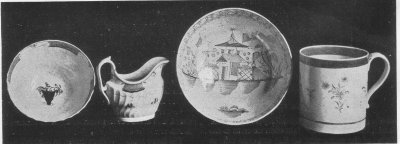
|
---------------------------------------------------------p.29--------------------------------------------------------------
No VIII. CUP AND COVER
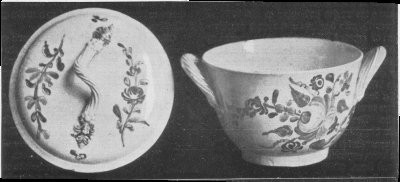
|
village among the hills as a product of the old Wirksworth
factory. We do not wish to force this consideration,
but there is something to be said for these and other
examples by reason of the permanence of old country
families in this quiet corner of Derbyshire.
No. I. shows the teapot with stand and cream jug;
No. II. a cup and saucer. There are six of these,latter,
the cups, like all others of the period, being without
handles. It will be noticed
that the teapot and cream
jug differ slizhtly in the handles.
But in every other respect
these and the cups and
saucers are strictly uniform
in style, body, and glaze.
The jug and teapot stand
may have been added during
the vicissitudes of a century
or more. The basin
(No. II.) does not belong to
the set, but it is evidently
of the same origin. The
colours are crimson, red
dish-brown, blue-green
and yellow, with swags of
dots in puce and little scrolls
at intervals. All the pieces
are much discoloured by age
and use.
In the early part of this
article a remark by Mr.W.
Bemrose was quoted concerning
a similarity between
the decorations on Lowestoft
china and that made at
Wirksworth. We presume
this writer was thinking of
the pink panels or labels,
filled with criss-cross,
scale, or waved lines, and
disposed along the borders
of certain Lowestoft
specimens. This very effective decoration is seen in
No. V. in a series of narrow cartouches or panels along
the edges. The more ornate teapot in.No. VI. shows
it also. The dotted swags in the Manor House set
(Nos. I. and II.), and similar forms in No. IV., are also
reminiscent of Lowestoft, as are also the ribbon loops
in No. V. The prevailing style of detached sprigs and
sprays of flowers is another
touch of ornament in common.
And as to the body,
the following passage
from How to Identify Old
China, by Mrs. Willoughby Hodgson,
is almost a
complete description of
much of the waste material
dug up at Wirksworth:
"Lowestoft porcelain is soft
paste, but not of uniform
softness. Indeed, some
pieces are very nearly allied
to hard paste. It is of a
creamy tint." The authoress
adds : ."The glaze is slightly
blued," which also describes
many of the Wirksworth examples.
Again, if we turn
to The China Collector, by
Mr. H. W. Lewer, we find
in the chapter on Lowestoft,
page 187, many details which
apply to the Wirksworth
examples.
With reference to the degree
of hardness, or softness,
of the Wirksworth
paste, we may add that it
resists a test which is always
effectual in respect of
the true soft variety. It
will not absorb colour, nor
show the slightest trace of
ink-stain, either upon the
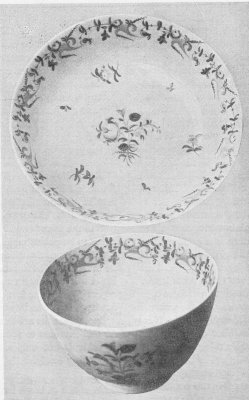
No IX. CUP AND SAUCER, IN THE DERBY ART GALLERY
(OLIVIER COLLECTION) PHOTO BY MR R KEENE
|
---------------------------------------------------------p.30--------------------------------------------------------------
biscuit surface or in the fracture. In Its unglazed condition
it has, when at its best, a beautiful eggshell
surface, and the more delicate fragments vary from a
sixteenth to a twentieth of an inch in thickness. They
often show traces of underglaze blue decoration.
No. III. shows a tea service belonging to Mr. William
Fox, of Wirksworth, who has by far the most considerable
collection of reputed Wirksworth china known to
the writer. The nucleus of this tea service was certain
pieces from the Bemrose collection. At a later date,
other exactly similar pieces were purchased at an important
sale in Wirksworth. They had long been in the
possession of a local family,
and were always considered to
be of local make.
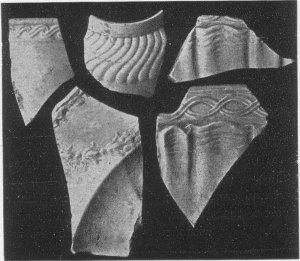
No X. UNGLAZED FRAGMENTS DUG UP ON
THE SITE OF THE WIRKSWORTH FACTORY IN 1914
|
The colours
are green, pink, blue, lilac, and
orange. The execution is free
and somewhat loose, especially
in the wavy red lines, which
run round in the form of swags
or festoons.
The set shown in No. IV. has
a still more curious history. A
teapot, stated by W. Bemrose
to be of Wirksworth make, had
long been in the possession of
Mr. Fox, when similar pieces of
a tea service came to light, belonging
to Mrs. Hamilton Gell,
now of Devonshire. The Gells
of Hopton and Wirksworth were among the partners of
the original undertaking. Other partners named by Jewitt
were the Hurts of Alderwasley and the Burdetts of Foremark,
both being local families of long-established standing.
There is other evidence in the Hurt family concerning
certain old china, long treasured for its family associations.
It closely resembles the specimens here illustrated.
No. V. shows two cups and saucers belonging to a set
which was, at one time, almost famous in Wirksworth,
so generally was it regarded as a relic of the old factory.
It belonged to a Mr. Richard Wall. But most
of the pieces have long since been dispersed. This was
evidently a very dainty and charming service. It is
painted with roses, bluebells, pinks, scattered sprays,
and bows of ribbon, and the pink cartouches along
borders, already referred to. There is a good deal of
this style of thing about Derby and neighbourhood, and
sometimes it is called Lowestoft by dealers. Others
loosely call it Staffordshire, or tell you they do not know.
An interested reader, seeing the illustration of these cups
and saucers in the Derbyshire Journal, sent the writer a
piece of a saucer which, he said, had always passed as New
Hall. Save that the paste is much whiter and the shape
fluted or gadrooned spirally, the whole thing is identical.
And the paste is about of the same degree of hardness.
Of the specimens shown in No. VI., the two teapots bear
a Bemrose attribution, and have been in, the possession
of Mr. Fox for some years. The glaze is a trifle uneven,
with a somewhat greasy reflection. The colouring shows
no novelty, but the tasselled ornament of one is very
effective. The cup and saucer, ribbed radially and with
scalloped edges, are decorated in gold and without colour.
They are charming specimens, and the only examples
yet discovered bearing gold enrichment. The authority
for their attribution is again Bemrose, and, according to
the exhibition catalogue, there should be other gold
decorated specimens about. See also the quotation from
Chaffers, page 26.
Other objects belonging to the same owner are the
basin and jug in No. VII. Here, again, is the characteristic
pink ornament. The jug is spirally fluted. The basin
shows a shell in heavy brownish colour (see again quota
tion from Chaffers), and roughly painted. The Oriental
dish is painted in an underglaze
blue pattern, which resembles
precisely certain fragments from
the wasters. The mug is clear
white, witb cornflower decorations
and lines. This and the
gold-and-white cup and saucer
seem of a superior quality.
The cup and saucer (No. IX.),
preserved in the Derby Art Gallery,
are the only examples of
Wirksworth china which the
museum contains. These objects
are quaint and charming.
The wing-like flowers are carried
out in blue. But the tone
of the glaze is somewhat heavy,
perhaps owing to age and use.
The photograph for this illustration was taken by special
permission of the committee.
With reference to the statements of various authors that
earthenware and lustreware were also made at Wirksworth,
we may add that the "finds" at the Manor House
tend to confirm these assertions. But, at present, the evidence
is incomplete. An interesting teapot, with a raised
arcaded pattern around it and scalloped edge, was shown
in the previous notice of this subject, but it appears to be
old salt-glaze, and has no clear evidence as to origin.
Should any readers of THE CONNOISSEUR be further
interested in this question, the writer will be glad to
receive communications on the subject. The writer
already owes thanks to numerous correspondents, and
also to the friends and collectors who have allowed their
china to be photographed.
And perhaps a word or two of personal explanation may
be allowed. The author holds no brief for the case, and
is not out to maintain any pet theory. The sole aim and
object is to sift the facts from the fiction, and the question
has been stated as impartially as possible.
Special thanks are due to the editor of this magazine
for the invitation to ventilate the subject in the interests
of what is not only a delightful pursuit, but a most
fascinating study.
[NOTE-Since writing the above, the author is indebted to a
distinguished authority for the information that a preliminary
chemical analysis indicates that they belong to the soft paste
variety, viz., a bone-ash porcelain. As stated, however, in the
text, they have, practically, a considerable degree of hardness.
Apparently they are related to the earlier period mentioned
above. See page 25.]
----------------------------------------------------end of article---------------------------------------------------------
